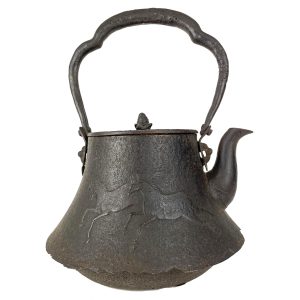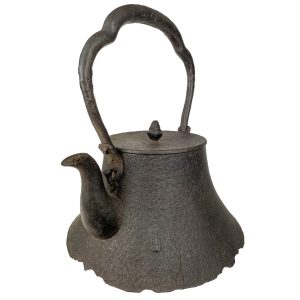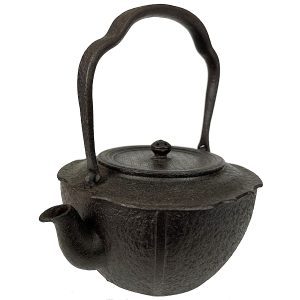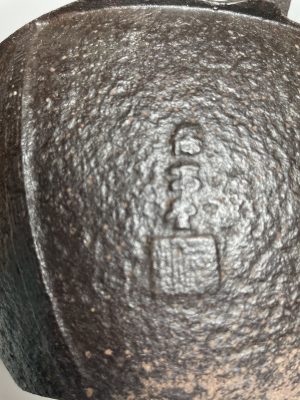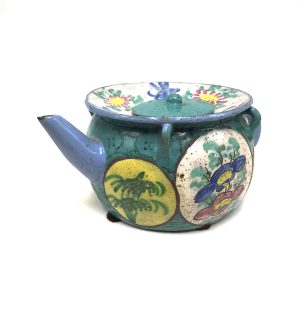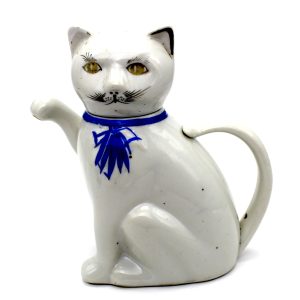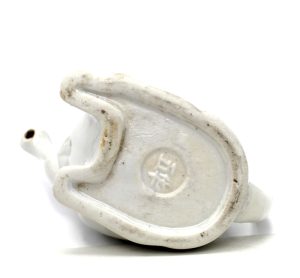Showing 1–12 of 23 results
-


$135.00
H: 5.25″ W: 4.625″ D: 2.375″ | FREE SHIPPING WITHIN CONTINENTAL U.S.!
This charming miniature ewer or small pitcher was made during the Tongzhi Period and probably used in a restaurant or home kitchen as a dispenser for soy sauce, oils or other liquids. With an elegantly curved spout and handle it is covered with chrysanthemums, plantain curved vertical leaves and bindweed vines. The lid has a lotus shaped bud for lifting, and the bottom has a Chinese antique export seal.
-
Sale!


$695.00 Original price was: $695.00.$550.00Current price is: $550.00.
Ht: 12.5″ W: 10″ D: 9.5″ | CALL 213-568-3030 OR EMAIL [email protected] FOR SHIPPING COST
Made in the Meiji era (1868-1912),this hand crafted antique Japanese cast iron tetsubin teapot has an unusual decorative handle and curved spout and has a beautiful relief design of galloping horses. Horses have been revered creatures in Japanese culture that embody grace, power and nobility. The knob on the lid probably represents a lotus, the Buddhist symbol of purity and enlightenment. As with all antiques, these pieces are purely decorative for display purposes only.
-
Sale!


$325.00 Original price was: $325.00.$275.00Current price is: $275.00.
Ht: 8.625” W: 7.5” D: 6.5” | CALL 213-568-3030 OR EMAIL [email protected] FOR SHIPPING COST
The hand crafted Tetsubin teapot displays simple yet elegant design: a scalloped top, gently curved handle, and short rounded spout, textured surface. The body is divided in 4 quadrants with meander border designs and the lid is has tiny diamond shaped indentations and is topped with a lotus shaped knob. A raised manufacturers seal on the back. Like all old Tetsubin cast iron kettles, it has rust on the bottom which can be removed by boiling green tea inside it, and is thus for display purposes only.
-
Sale!


$295.00 Original price was: $295.00.$225.00Current price is: $225.00.
Ht: 9.25″ W: 8″ D: 7.25″ | CALL 213-568-3030 OR EMAIL [email protected] FOR SHIPPING COST
This Meiji (1868-1912) hand crafted cast iron Tetsubin is especially charming with a textured surface, unique shape and temple ornamental knob on its lid. Two manufacturer’s seals are impressed on its side. The outside is in excellent condition. Since, like all old Tetsubin cast iron kettles, it has developed rust on the bottom that can be removed by boiling green tea, it is recommended for display only to enhance any style kitchen.
-
Sale!


$365.00 Original price was: $365.00.$295.00Current price is: $295.00.
H: 2.625” W: 6.125” D: 4” | FREE SHIPPING WITHIN CONTINENTAL U.S.!
This delicate antique Yixing teapot is unusually shaped with a loop handle, short spout, flaring rim, small flat cover and small loops below its rim that indicate it may have been used to suspend oil or soy sauce rather than serve tea. Its charm is enhanced by its free hand-painted colored enamels with 6 circular panels containing fanciful and bright floral and leaf decorations. Chinese tea connoisseurs consider Yixing teapots the best vessel for brewing tea as it is naturally porous to absorb oils released during brewing and improves tea’s flavor with continual use. Recommended for display only, it pairs well with 1152A-PAR Enameled Yixing Stoneware Teapot.
-
Sale!


$365.00 Original price was: $365.00.$295.00Current price is: $295.00.
H: 2.6 ” W: 6.1 ” D: 4 ” | FREE SHIPPING WITHIN CONTINENTAL U.S.!
This delicate antique Yixing teapot is unusually shaped with a loop handle, short spout, flaring rim, small flat cover and small loops below its rim that indicate it may have been used to suspend oil or soy sauce rather than serve tea. Its charm is enhanced by its free hand-painted colored enamels with 6 circular panels containing fanciful and bright floral and leaf decorations. Chinese tea connoisseurs consider Yixing teapots the best vessel for brewing tea as it is naturally porous to absorb oils released during brewing and improves tea’s flavor with continual use.
-
Sale!


$395.00 Original price was: $395.00.$285.00Current price is: $285.00.
H: 9″ W: 8.375″ D: 5.5″ | CALL 213-568-3030 OR EMAIL [email protected] FOR SHIPPING COST
This very attractive antique green glazed teapot is typical of the stoneware pottery made in the Shiwan kilns in Guangdong during the 18-19th century. Finely designed, this hexagonal pot has a yoked rounded handle with spiral decorations that adds a delightful touch. The pieces are well known for their brilliant flambé—or flame-like quality – glazes such as apple green glaze of this pot.
-


$145.00
Ht: 6.25” W: 5.5” D: 3.25” | FREE SHIPPING WITHIN CONTINENTAL U.S.!
This charming antique white glazed porcelain figurine is a cat teapot with a raised paw with removable head for pouring liquid into the vessel and long sinuous tail as a handle to pour liquid from the opening at the end of the paw. The hand painted design is whimsical and colorful with a thin ribbon-like blue collar and a dangling ornamental bow with black accents defining the face, ears, head and paws.
-


$235.00
H: 4.875″ W: 4.5″ D: 3.25″ | FREE SHIPPING WITHIN CONINENTAL U.S.
This elegantly shaped and beautiful high-fired antique porcelain ewer was decorated on its outside with a saffron-colored glaze called a coral red glaze. The sides have a white glazed quatrefoil panel with hand-painted multi-colored floral designs on a white background within a gold frame interspersed among sinuous gold leaf vines across the body and neck and a white glaze covers the inside and bottom. Its beauty is enhanced with its graceful spout, colorful white and gold panel beautiful.
-


$135.00
H: 5” W: 5.25” D: 4.5” | FREE SHIPPING!
Utilitarian ceramics like this were used in home kitchens and restaurants to hold oil, sauces, soy or other liquids. This spouted blue and white porcelain jar has four loops, also called lugs, so a natural fiber such as rattan could be threaded to either secure a top create a way to hang it to a peg. Sealing the top was very useful if the jars contained liquid and needed to be transported. The piece is decorated in a free and expressive manner with a charming impression of a country scene of a building in a landscape surrounded by tall trees. The cobalt is thick and dark in some areas of the foliage and applied with a thin, sparing and light brush elsewhere.
-
Sale!


$265.00 Original price was: $265.00.$215.00Current price is: $215.00.
H: 4” W: 5.25” D: 3.5” | FREE SHIPPING WITHIN CONTINENTAL U.S.
This delicate Meiji single serving Kyo Ware teapot with a high handle ,like all antique Kyo pieces was hand thrown and hand-painted. This small, striking teapot was fired to create a luminescent beige color with a crackled glaze resulting in a glowing radiance and has the Kiyomizu kiln seal where it was made on the bottom. The chrysanthemum (kiku in Japanese) in a basket in blue and red on the body and lid symbolizes longevity and rejuvenation. . Production of Kyo ware is limited, making it highly collected worldwide.
-


$135.00
H: 5.5″ W: 3″ D: 3.375″ | FREE SHIPPING WITHIN CONTINENTAL U.S.!
This charming white porcelain cat teapot has a removable head, a long sinuous tail handle, and an opening at the end of its paw to serve tea. The hand painted design is whimsical and colorful featuring a thin ribbon-like gold collar and dangling ornamental bow and black accents and pink strokes that define the face, eyes, ears, head and paws.
End of content
End of content



